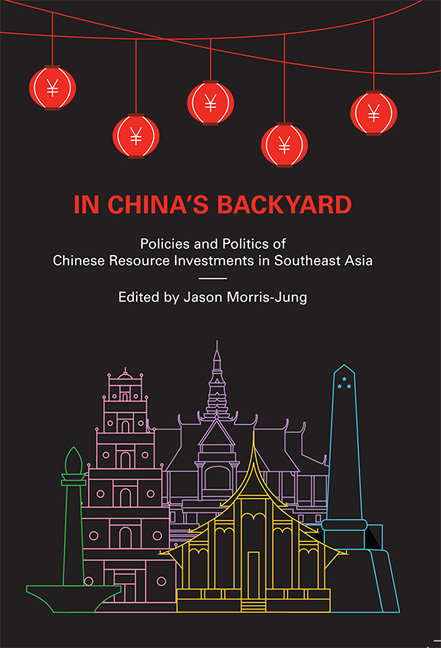Book contents
- Frontmatter
- Contents
- Foreword
- Acknowledgements
- About the Contributors
- 1 Introduction
- 2 Mixed Motivations, Mixed Blessings: Strategies and Motivations for Chinese Energy and Mineral Investments in Southeast Asia
- 3 Mineral Resources in China's “Periphery” Diplomacy
- 4 Energy Entanglement: New Directions for the China–Indonesia Coal Relationship
- 5 Indonesia–China Energy and Mineral Ties: The Rise and Fall of Resource Nationalism?
- 6 The Direction, Patterns, and Practices of Chinese Investments in Philippine Mining
- 7 Development Cooperation with Chinese Characteristics: Opium Replacement and Chinese Rubber Investments in Northern Laos
- 8 The High Cost of Effective Sovereignty: Chinese Resource Access in Cambodia
- 9 Complex Contestation of Chinese Energy and Resource Investments in Myanmar
- 10 Anti-Chinese Protest in Vietnam: Complex Conjunctures of Resource Governance, Geopolitics and State–Society Deadlock
- 11 Complexities of Chinese Involvement in Mining in the Philippines
- 12 Conclusion
- Bibliography
- Index
2 - Mixed Motivations, Mixed Blessings: Strategies and Motivations for Chinese Energy and Mineral Investments in Southeast Asia
Published online by Cambridge University Press: 04 July 2018
- Frontmatter
- Contents
- Foreword
- Acknowledgements
- About the Contributors
- 1 Introduction
- 2 Mixed Motivations, Mixed Blessings: Strategies and Motivations for Chinese Energy and Mineral Investments in Southeast Asia
- 3 Mineral Resources in China's “Periphery” Diplomacy
- 4 Energy Entanglement: New Directions for the China–Indonesia Coal Relationship
- 5 Indonesia–China Energy and Mineral Ties: The Rise and Fall of Resource Nationalism?
- 6 The Direction, Patterns, and Practices of Chinese Investments in Philippine Mining
- 7 Development Cooperation with Chinese Characteristics: Opium Replacement and Chinese Rubber Investments in Northern Laos
- 8 The High Cost of Effective Sovereignty: Chinese Resource Access in Cambodia
- 9 Complex Contestation of Chinese Energy and Resource Investments in Myanmar
- 10 Anti-Chinese Protest in Vietnam: Complex Conjunctures of Resource Governance, Geopolitics and State–Society Deadlock
- 11 Complexities of Chinese Involvement in Mining in the Philippines
- 12 Conclusion
- Bibliography
- Index
Summary
Chinese energy and mineral companies have been investing overseas formore than twenty years, and the quantity and size of their projects havebeen growing steadily. Although Southeast Asia is not a preferred regionfor these investments, they remain significant on account of their relativevalue to the host country and because of the geostrategic importance ofthe region for China. Most of the companies making the investmentsor undertaking the projects are wholly or partly owned by the Chinesegovernment at either central or local levels. As a result, the motivations fortheir investment activities reflect a mix of corporate and state objectives.Corporate objectives include securing energy or resource supply chains,increasing or diversifying their asset base, and enhancing their profits ormarket share. Government motivations range from direct support tocompanies for purposes of industrial strategy and resource security toindirect support through development assistance, diplomacy and regionalstrategic positioning.
This chapter presents an overview of the scores of investments and majorinfrastructure projects undertaken by Chinese companies in Southeast Asiain oil and gas, coal, hydroelectricity and metalliferous mining, showing howthe mix of motivations for these activities varies between industries and, toa lesser extent, between host countries. While the economic benefits of theseinvestments to host countries are in most cases evident, there are some risks.The lack of transparency and low operating standards that characterize someprojects can weaken the social license to operate, creating risks for both theChinese companies and the host governments
Introduction
China's economic engagement in Southeast Asia has grown markedly in recent years, and this includes the energy and mining industries. In addition to importing energy and mineral commodities from the region, Chinese enterprises have been investing in primary resources and constructing energy infrastructure. While the objectives of these companies are often primarily commercial, they are also multi-faceted and involve the ambitions of both the enterprises and the Chinese government. In addition, this mix of objectives varies between the different resource industries. The aims of this chapter are to identify the specific motivations of Chinese enterprises and government in their engagements with Southeast Asia's energy and mineral resources, and examine some of the implications from their mix of corporate and state drivers.
- Type
- Chapter
- Information
- In China's BackyardPolicies and Politics of Chinese Resource Investments in Southeast Asia, pp. 27 - 56Publisher: ISEAS–Yusof Ishak InstitutePrint publication year: 2017

